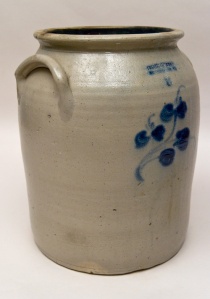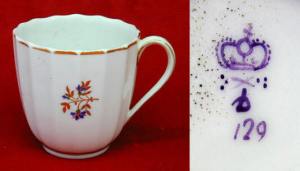Category Archives: Ceramics
Stoneware Jars and Crocks
 An acquaintance of mine recently hired an estate sales professional to handle her late mother-in-law’s houseful of Stuff. As the woman walked through the house for the first time to assess the Stuff, she pointed to various items and said, “This is worth about such-and-such.” On the porch was a dirty, clunky stoneware jar about 2 feet tall. As the woman bent to examine it more closely, my acquaintance said that she was about to throw that ugly old thing away. “Don’t do that,” said the estate sales professional–“it’s worth about $8,000.”
An acquaintance of mine recently hired an estate sales professional to handle her late mother-in-law’s houseful of Stuff. As the woman walked through the house for the first time to assess the Stuff, she pointed to various items and said, “This is worth about such-and-such.” On the porch was a dirty, clunky stoneware jar about 2 feet tall. As the woman bent to examine it more closely, my acquaintance said that she was about to throw that ugly old thing away. “Don’t do that,” said the estate sales professional–“it’s worth about $8,000.”
Clunky old stoneware crocks or storage vessels have significant monetary value, even though they may not look attractive to you. Folk art ceramics of all sorts are highly collectible. Take them to two or three antiques dealers for verification and ask what they would pay.
Pottery Marks: Dishwasher Safe
 Have you heard the myth about the origin of the word “china?” An auctioneer told me that he first heard this from his father, also an auctioneer, and that he repeated it himself for years. Then he looked into the subject and learned it wasn’t true. The myth goes like this: The reason people today call dishes china is because after the 1890 tariff act, dishes imported into the U.S. were required to have a mark indicating country of origin. Since most of the dishes came from China and were marked “CHINA,” people started referring to all dinnerware as china.
Have you heard the myth about the origin of the word “china?” An auctioneer told me that he first heard this from his father, also an auctioneer, and that he repeated it himself for years. Then he looked into the subject and learned it wasn’t true. The myth goes like this: The reason people today call dishes china is because after the 1890 tariff act, dishes imported into the U.S. were required to have a mark indicating country of origin. Since most of the dishes came from China and were marked “CHINA,” people started referring to all dinnerware as china.
Not exactly. The general term was in use long before 1890. Historians know that because it is common to see the word china in inventories dating back to the 18th century at least. But the word can help you date your piece of china, because it shows that it was imported after 1890 and is not, for example, an 18th-century piece. But it is true that, as Chinese-export porcelains came into Europe in the 1600s and as Europeans tried hard to figure out the mystery of this lovely, translucent ware and make it themselves, the English began referring to all porcelain-like ceramics as china, even when the stuff was produced in France (Sevres, Limoges), Germany (Meissen), England (bone china), or other countries.
Generally speaking, the more wordy information stamped on the back of a piece of china, the younger it is. If it says “Dishwasher safe,” it isn’t very old. (Don’t laugh. I remember getting a letter from a woman who had a handmade pottery mug with the inscription “1776 — 1976” on it, and she was wondering how much it was worth, since it was obviously more than 200 years old. It did say 1776, didn’t it?)
But there’s no need to guess. There are plenty of guides to pottery marks in your library or on line. Like these:

